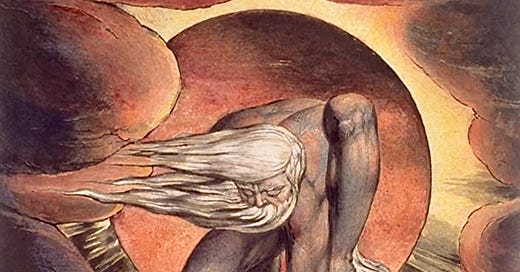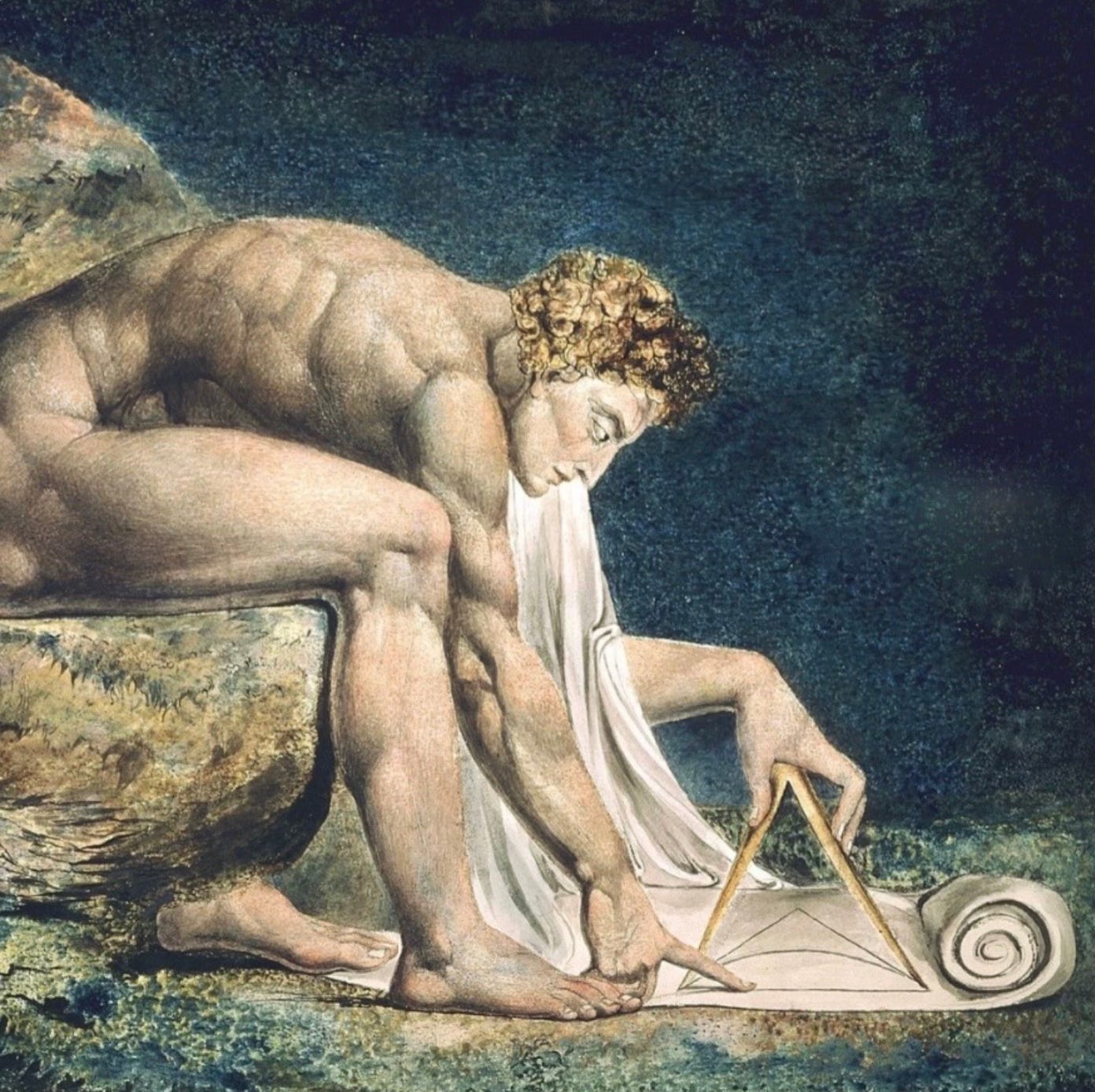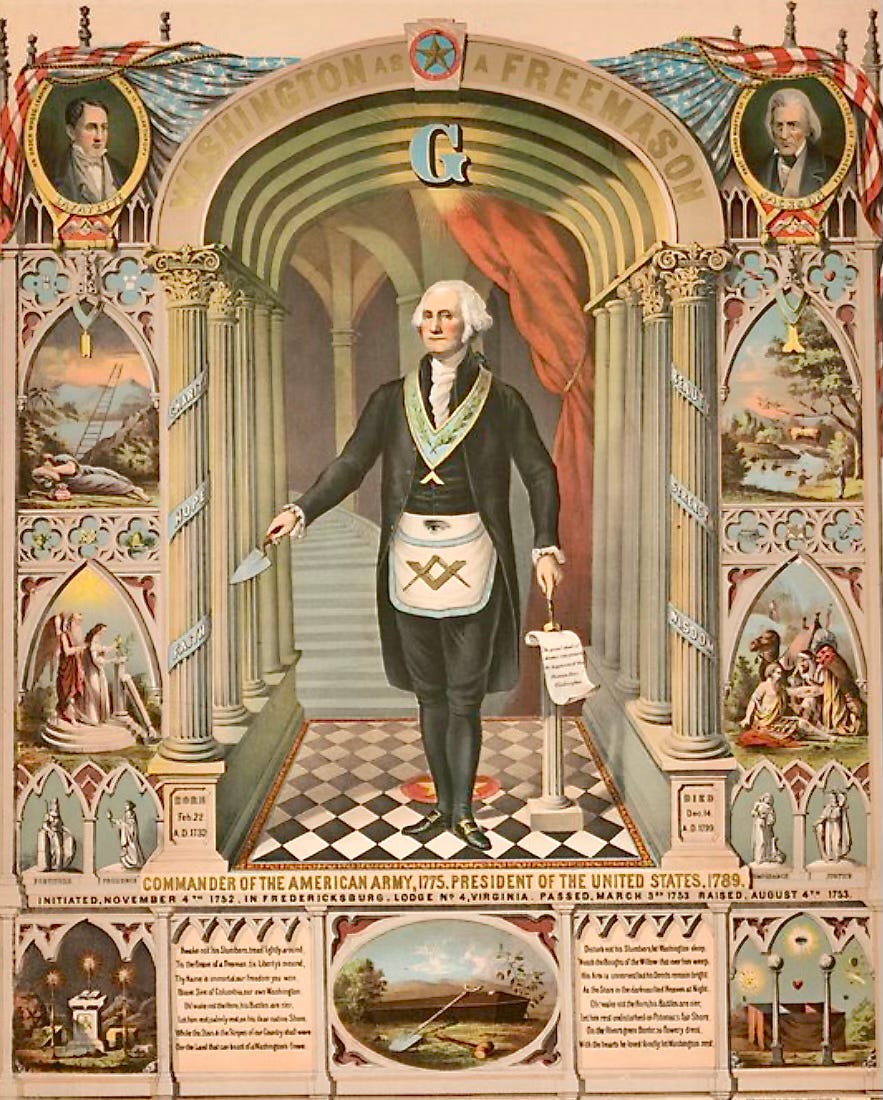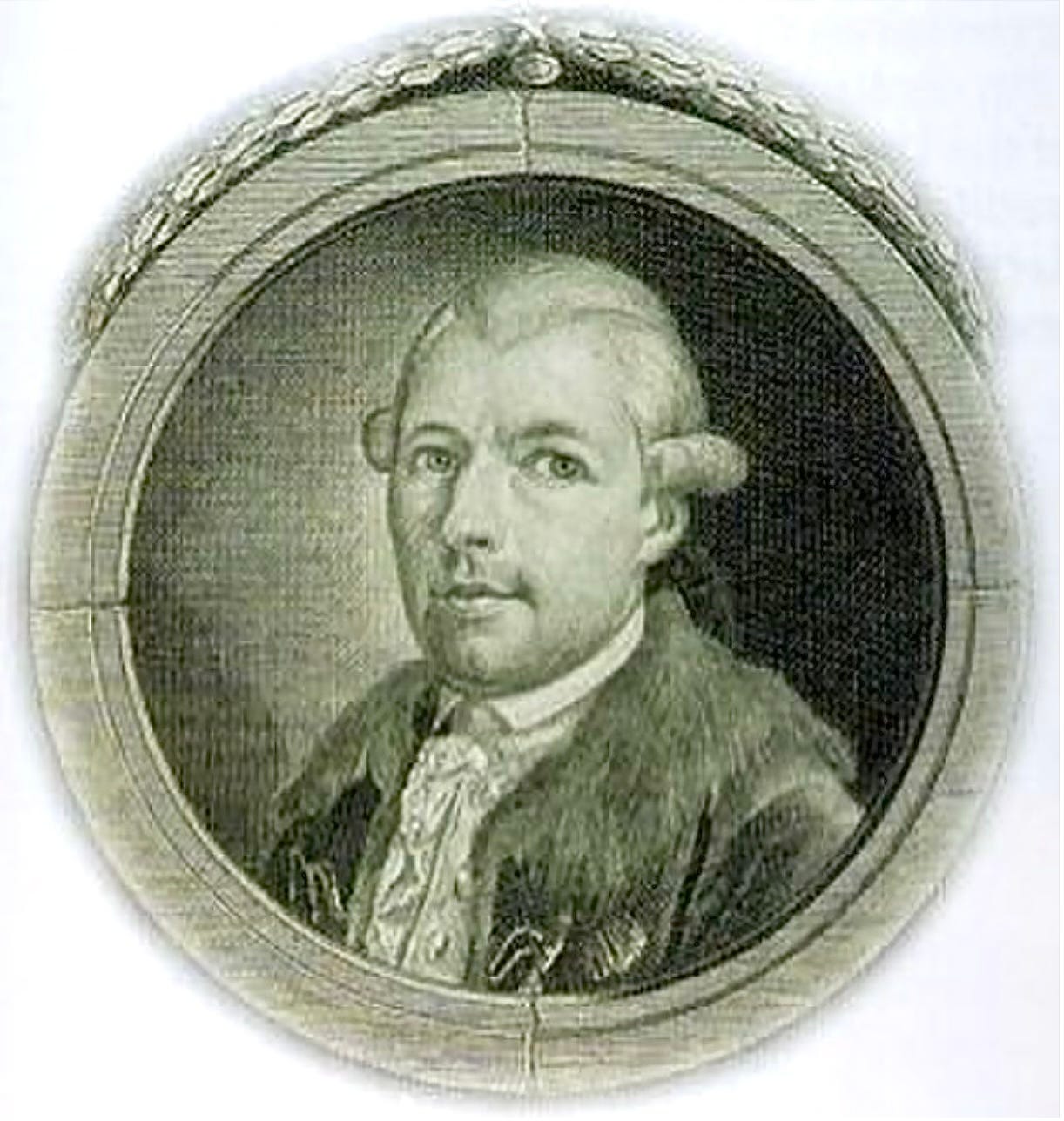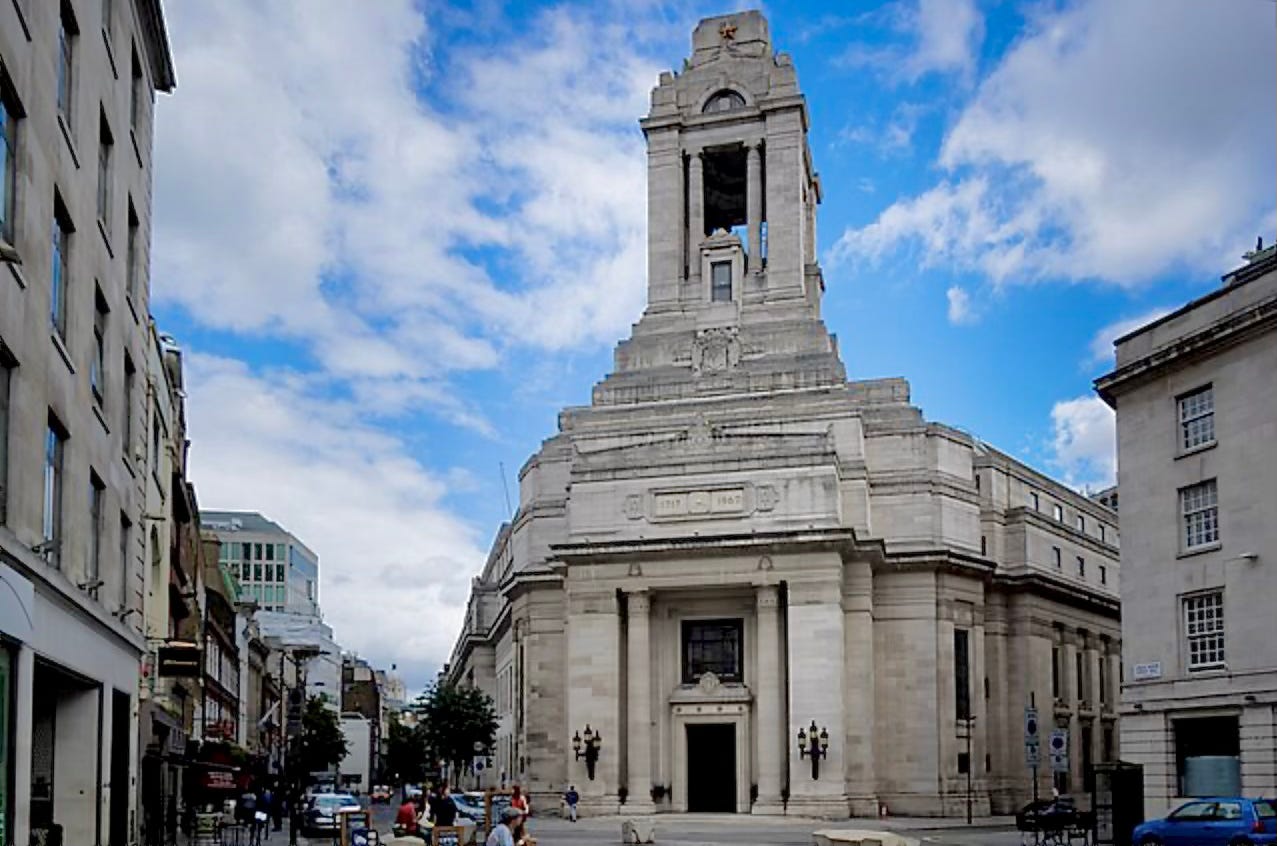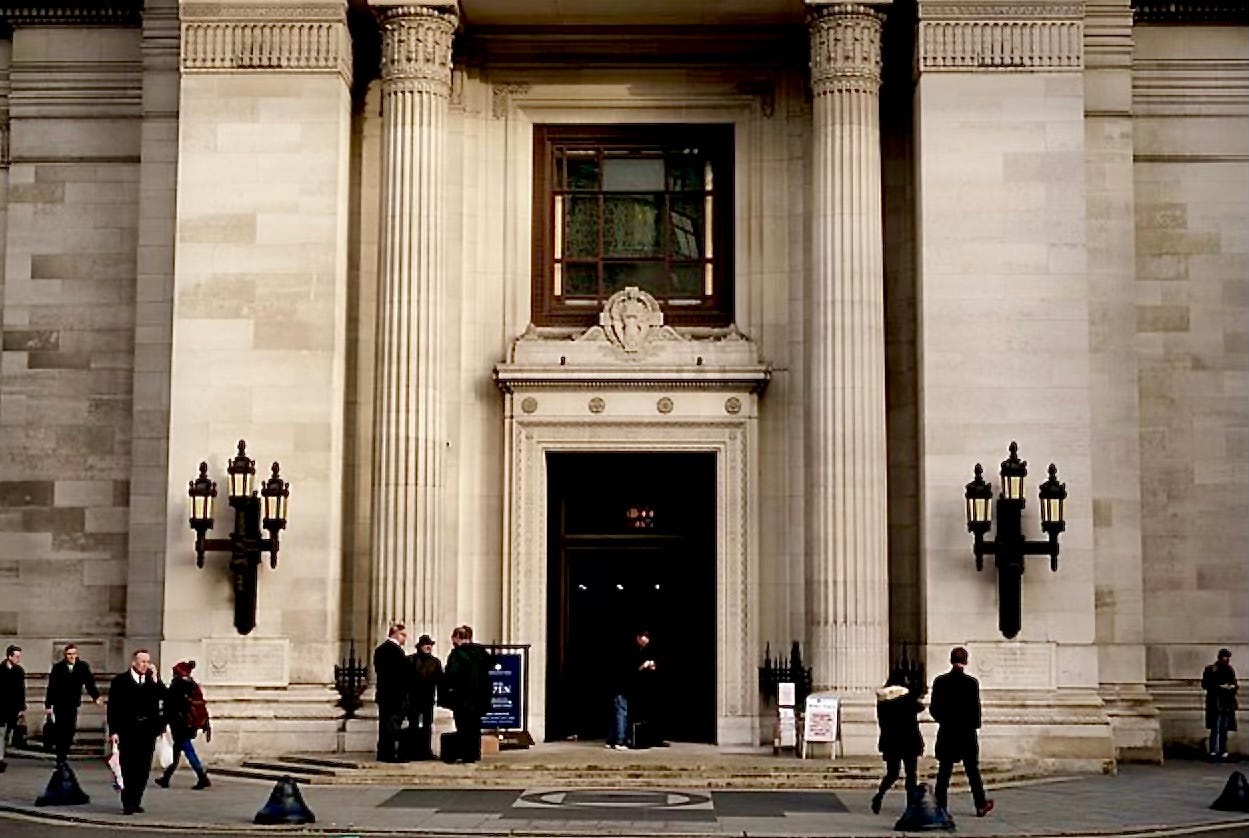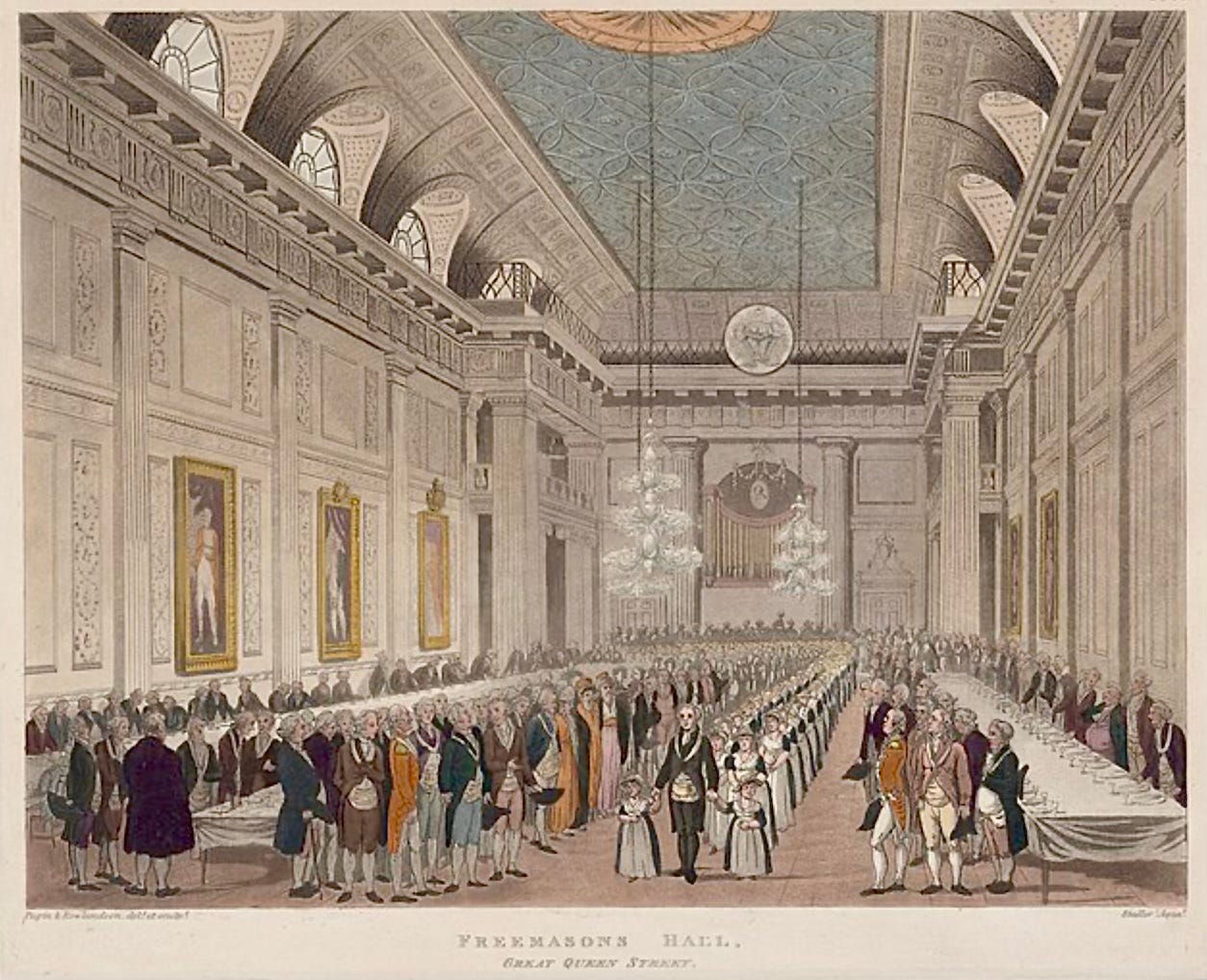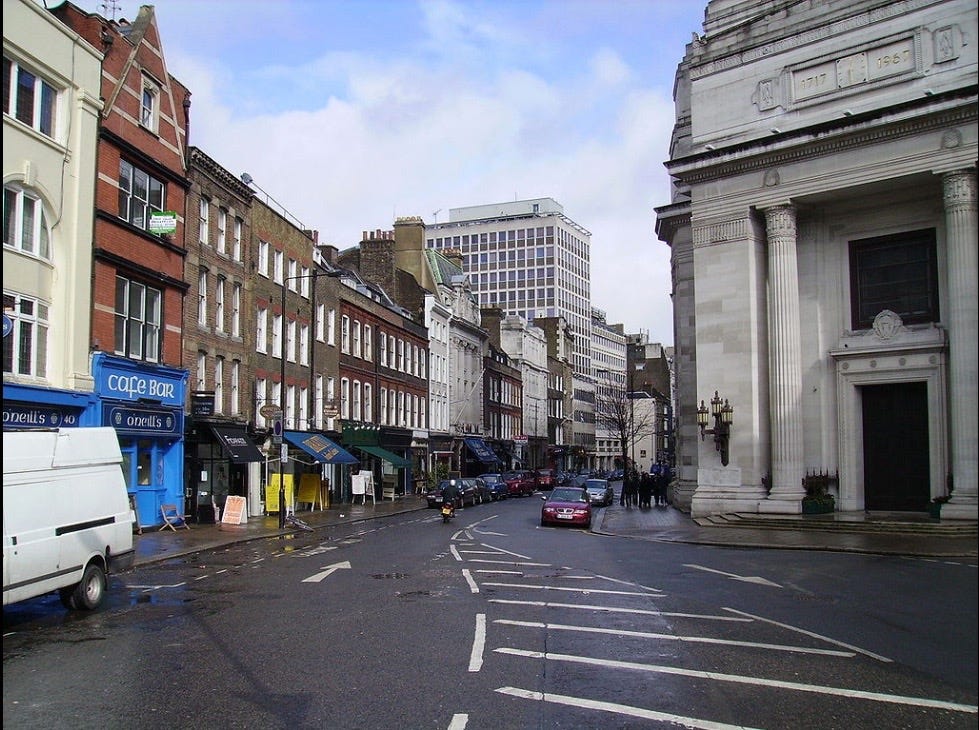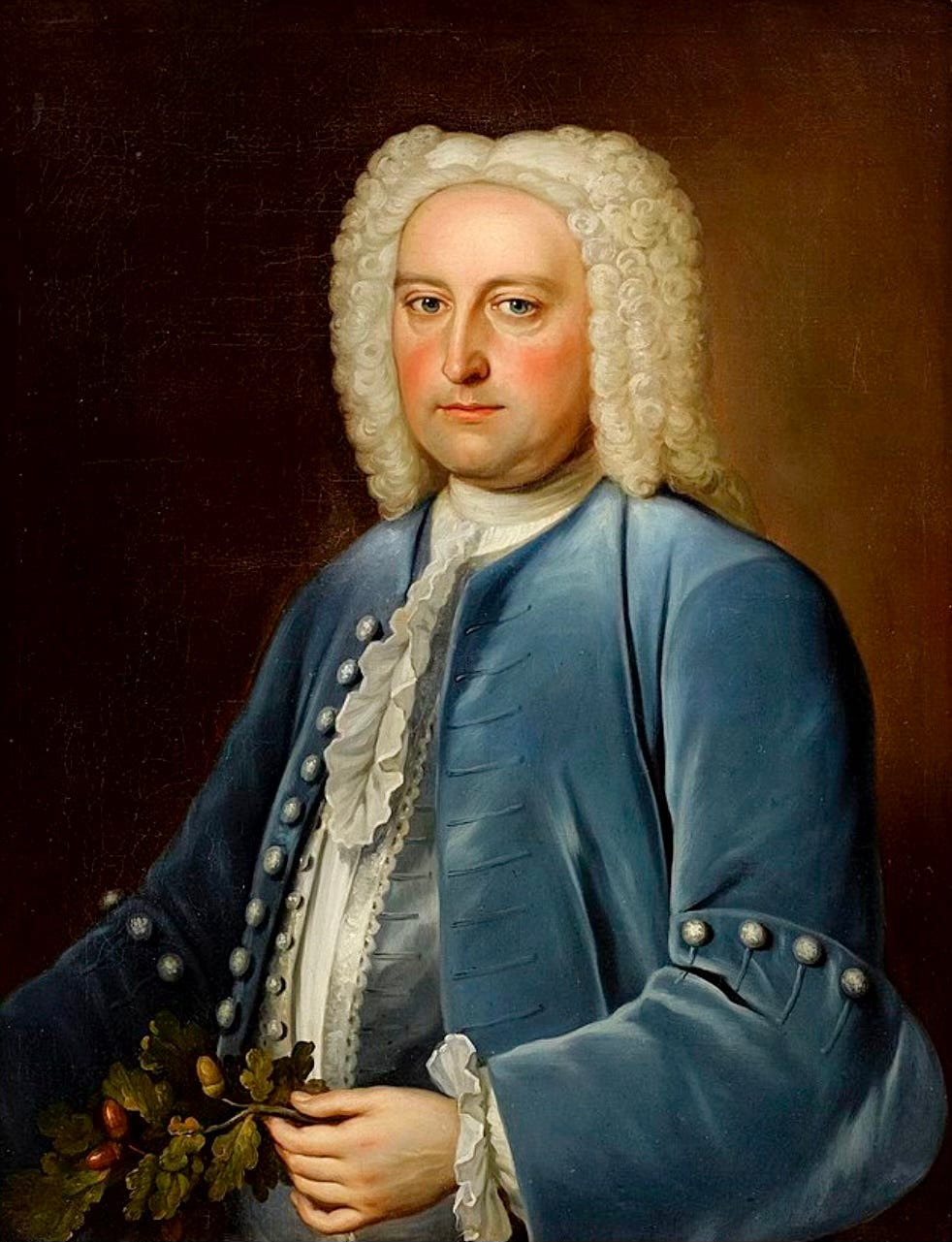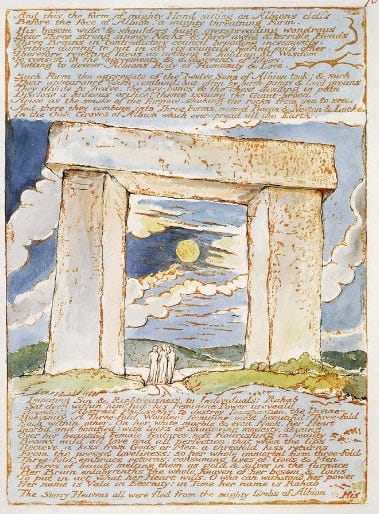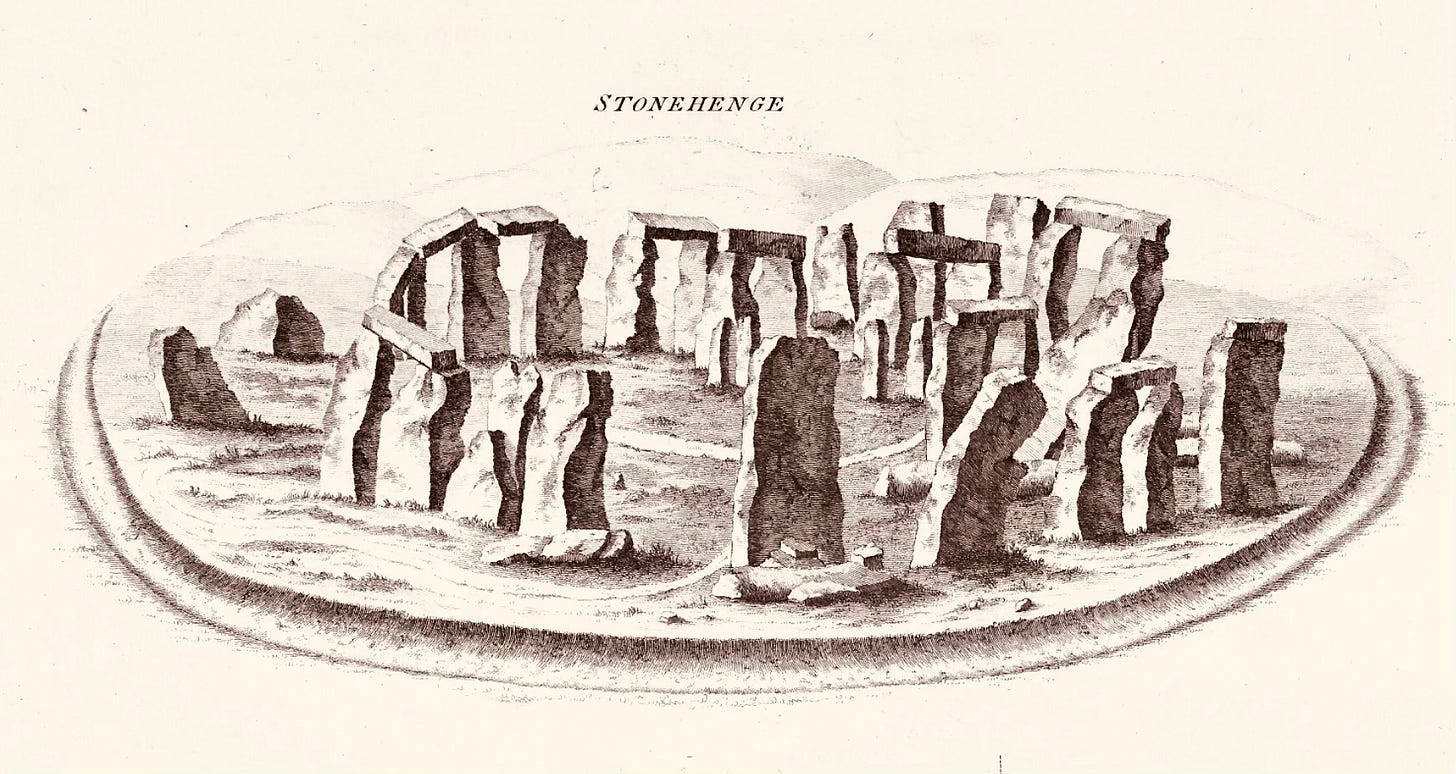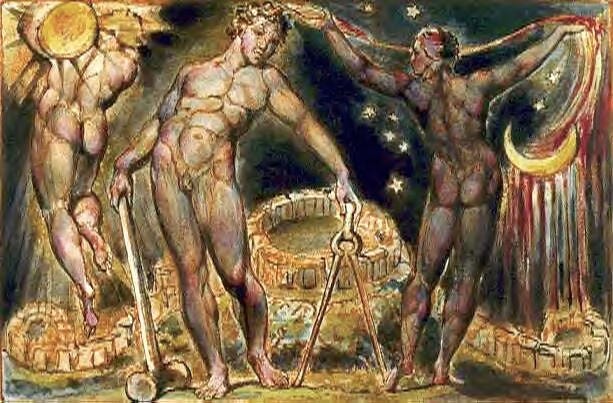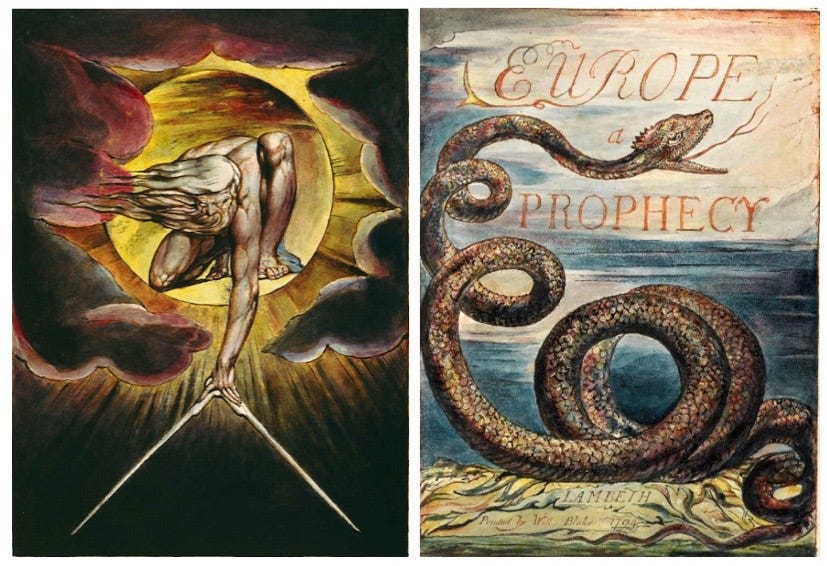The Golden Compasses: William Blake and Freemasonry
The Single Eye, the Dividers, and the Pyramid: Understanding the God of This World
Introduction
Blake has always attracted those who are interested in the esoteric, the occult, and the deeper or more spiritual systems of thought. In his own time (1757-1827), Freemasonry was one of the most prominent and progressive of these systems – its members included Goethe, Mozart, Voltaire, and many of the key architects of the American and French revolutions (Benjamin Franklin, George Washington; Lafayette, Marat, Danton, and Robespierre), which have therefore often been seen as essentially Masonic projects.
George Washington, one of the key architects of the American revolutions, in his Masonic apron. Note where the compasses are on them.
Many have suggested that Blake himself may have been a Freemason. There is no evidence of this however, and it seems highly unlikely given his challenging and radical critiques of existing systems of belief, including Freemasonry, as we’ll see. But he certainly moved in circles where Masonic thinking was a norm, and he clearly had access to some of the most secretive and profound ideas and symbols used in the Craft.
In 1938, Anthony Blunt suggested that Blake’s use of the compass in The Ancient of Days might have owed something to a Masonic influence, and since then there have been several attempts by scholars to further trace the connection between William Blake and Freemasonry. As Rob Allen helpfully remarks in Freemasonry, Blake and the Compass (2010):
The most detailed studies have come from Marsha Keith Schuchard who, since the late 1980s, has published articles contextualising Blake’s work within the cloak and dagger world of late eighteenth-century Freemasonry. In order to do this, Schuchard’s argument rests on establishing Blake firmly within the social milieu of political radicals participating in illuminist Masonic groups. These groups, labelled as illuminist due to their deep engagement with ‘cabalistic and Hermetic studies’ and their highly secretive nature, emerged from ‘Stuart traditions of Scottish, Irish, French and Swedish Masonry’.
The secrecy was not only a result of these groups’ esoteric interests, but also of their radical political and religious affiliations at a time when European powers were highly sensitive to the threat of instability. In the light of the French revolution, the recent regency crisis in England and the revelations about the Bavarian Illuminati, the 1790s saw the growing fear of ‘sinister conspiracies’ involving clandestine, fraternal associations. At the same time, a marked division had taken place within English Freemasonry between Illuminist Masons, the so-called Ancients, and the Moderns, who were dedicated to ‘Newtonian science’ and the British monarchy.
According to Schuchard, Blake’s image alluded to the Supreme Architect characterized by the ‘regular’ Freemasonry of the Moderns and was a veiled comment on contemporary political events as seen through the lens of Illuminist Masonry. In particular, Schuchard points out the recent about-face by the Prince of Wales and his supporters following their failed efforts to seize control during the regency crisis. Having switched allegiance from the Ancient Masonic lodges (with their networks of illuminist radicals) to an avowedly conservative Modern lodge, they made a public oath of loyalty at Freemasons’ Hall in1792 pledging allegiance to George III in terms that characterized God as the ‘Supreme Architect of the Universe, whose Almighty Hand hath laid in the Deep the Firm Foundation of this Country’s Greatness’.
As Allen notes, in the context of the extraordinary political and social upheavals of the eighteenth century, and the widespread appearance of the involvement of notable Freemasons in revolutions on both sides of the Atlantic, many conservative and liberal thinkers forged a connection between the secretive and seemingly subversive nature of Freemasonry and its role and involvement in radical political change.
Adam Weishaupt (1748–1830), founder of the Bavarian Illuminati. Weishaupt early on decided to develop the existing German Freemason Lodge as a shortcut to gain esoteric hegemony over the occult world, ‘in order to extend Illuminati influence into the society at large and the government’
The most well-known and widely-read of these thinkers was Abbé Barruel, whose monumental Memoirs Illustrating the History of Jacobinism (1797-98, 4 volumes) claimed to have uncovered a continent-wide conspiracy to overthrow all existing governments, monarchies, and Christian churches, through a network of coalition of philosophes, Freemasons, and the Order of the Illuminati (another secretive organisation, with strong links to Freemasonry), founded in Bavaria by Adam Weishhaupt. Barruel’s work and ideas swept through the courts of Europe like wildfire, causing consternation and panic at this suggestion of a coordinated and very secret project aimed at removing the old world order, or Ancien Régime.
As Robert Rix notes in William Blake and the Radical Swedenborgians:
In the fourth volume of his piece of scare-mongering, Barruel singles out the Swedenborgian Masons for particular attention (esp. 4:119-51), because he sees them as the heretical glue that binds together a variety of what he calls ‘antisocial’ (i.e. revolutionary) societies. He describes Swedenborg’s visions as ‘prophecies of rebellion’ and his teaching as intended to ‘eradicate true Christianity from the minds of their dupes, and to make their New Jerusalem a plea for those revolutions’ that aim to overthrow ‘the present churches and government’ (4:132). The underlying meaning of the claim for spiritual regeneration is really ‘to sweep from the earth every prince and every king, that the God of Swedenborg may reign uncontroled [sic] over the whole globe.’ And that revolution which they saw bursting forth in France, was nothing more in their eyes than the fire that was to purify the earth to prepare the way for their new Jerusalem (4:126).
As this observation suggests, Blake would undoubtedly have been sympathetic to at least some of these ‘Swedenborgian’ aims and ideas, and their vision of instigating a ‘New Jerusalem’. And as Schuchard herself notes in The Secret Masonic History of Blake’s Swedenborg Society, Blake was very much part of this radical and esoteric scene in the latter half of the eighteenth century:
To serve both his political agenda and his theosophical ambitions, Swedenborg utilized a network of Masonic lodges in England and Sweden that were linked with sister lodges in France, Holland, Germany, Poland, and Russia. By the time of his death in March 1772, these ‘illuminated’ Masons were laying the foundations of the Swedenborgian Theosophical Society that Blake joined in the 1780s.
Schuchard notes that by the 1780s many of Blake’s friends were members of Ancient Masonic lodges with ties to radical American, French and Swedish masons, including the artists Henry Fuseli and John Opie, both friends of Blake. Many gatherings of artists took place at Freemasons’ Hall, including several that Blake or his friends are known to have attended. Indeed, Blake served his engraving and artistic apprenticeship with James Basire, who lived and worked directly opposite the imposing Freemasons’ Hall, on the other side of Great Queen Street.
The construction of the Masonic hall, which included Freemasons Tavern, took place between 1771 and 1776, and was formally dedicated ‘in solemn form to Masonry, Virtue, Universal Charity, and Benevolence’ on 23 May 1776. This was exactly the same time that Blake was serving his engraver’s apprenticeship (begun on 4 August 1772, when Blake was fourteen years old, and lasting seven years). Blake not only worked with Basire during this period but also lived in his house, opposite the Masonic hall being magnificently constructed outside his windows. At both the laying of the foundation-stone and the dedication of the finished building, full Masonic ceremonies were performed which could not have been missed by the engravers across the street.
Freemasons’ Hall, Great Queen Street, London, just opposite Basire’s, where Blake lived and worked as an apprentice engraver for seven years (1772–79). Lower pic: Great Queen Street, looking east. Freemasons’ Hall is on the right, and where Basire’s would have been is on the left.
As Schuchard explains, the proximity and intense symbolism of these ceremonies would not have been lost on a mind so eager and curious as Blake’s:
The importance of Freemasons’ Hall to many of Blake’s known associates reveals the major role it played in London political and artistic life. Thomas Paine, whom Blake knew personally in 1792, described Freemasons’ Hall as a ‘magnificent building, with a burnished gold roof of the sun and the zodiac,’ which he interpreted as Druidical emblems. Paine discussed the Masons’ Druidic rites and theories, their magical practices, and their importance as a liberal, international social-political force.
Another Masonic associate of Blake’s, the engraver Bartolozzi, produced a famous engraving, ‘The Genius of Masonry,’ a picture of Freemasons’ Hall in 1786. One of Bartolozzi’s other Masonic engravings for Freemasons’ Hall was made from Thomas Stothard’s painting; Stothard too was a Mason and an intimate friend of and collaborator with Blake.
‘Masonic chart of the Scottish rite (1874)’ from the Library of Congress. Note the symbolism: compasses/dividers, the checkered floor, the pentagrams, the twin columns of Solomon’s Temple, and the detached Single Eye. This denotes a rational, architectural, geometrical world ruled by a rational, architectural, geometrical God. The 1784 edition of ‘The Constitutions of the Free-Masons’ by James Anderson (which included Bartolozzi’s engraving of ‘The Genius of Masonry’), contained a history of Freemasonry starting with the creation of the world by the ‘great Architect of the Universe’. Anderson also claimed that Adam had taught his sons the science of geometry and that Noah, ‘the ninth son of Seth, was commanded and directed of God to build the great Ark, which, tho’ of Wood, was certainly fabricated by Geometry, and according to the Rules of Masonry.’ Thus, Masonry existed from time immemorial. Masonry can be divided into two subcategories: (1) operative and (2) speculative. Speculative Freemasonry is what Masonic Lodges practice throughout the world today. The Speculative Freemason uses the working tools of the operative mason and looks to them as symbols.
The Society of Antiquaries, Stonehenge, and William Stukeley
Portrait of William Stukeley (c. 1726-1729)
Thomas Paine’s long essay on Masonic Druidism points to another area of experience and of possible friendships for Blake – his interest in and work for the Society of Antiquaries during his apprentice years. In 1718, William Stukeley had helped to found the Society of Antiquaries and served as Secretary until 1727. In 1720 he also joined the Freemasons, seeking for hidden knowledge of ‘the mysterys of the ancients.’
In 1740 Stukeley published Stonehenge. a Temple Restored to the British Druids, and in 1743, Abury, a Temple of the British Druids. The books demonstrated his theory that Druidism was ‘the aboriginal patriarchal religion,’ and stressed the role of the Tyrian Hercules, great grandson of Noah and builder of the serpent-temples.
In awful pomp & gold, in all the precious unhewn stones of Eden
They build a stupendous Building on the Plain of Salisbury; with chains
Of rocks round London Stone: of Reasonings: of unhewn Demonstrations
In labyrinthine arches. (Mighty Urizen the Architect.)– Blake, Jerusalem: The Emanation of the Giant Albion
Above: trilithons from Stukeley’s Stonehenge. a Temple Restored to the British Druids; Below: Blake’s version of it in Jerusalem: The Emanation of the Giant Albion
‘Mighty Urizen the Architect’ signals Blake’s nod to this link between Masonic Druidism and the ‘Great Architect of the Universe’ (GAOTU), the same ‘Urizen the Architect’ as shown on the Frontispiece to Europe, with the same masonic compasses that Blake suggests in his striking illustration on the final plate of Jerusalem.
The final plate of Blake’s Jerusalem, with the Druidic stones in the background. As the William Blake Archive note in their commentary on this plate, ‘Behind the figures, a serpentine line of trilithons winds, like a long wall, across a grassy landscape dominated by a single hill in the center. The line of trilithons, which may represent one of the "Serpent Temples" mentioned on Plate 80, line 49, forms a larger circle on the central hilltop and smaller loops approximating circles at each end.’ The ‘serpentine’ form of these almost exactly replicates an image from Stukeley’s own illustrations of Stonehenge and Abury.
‘A Scenographic view of the Druid temple of Abury in north Wiltshire, as in its original’, from Stukeley’s ‘Abury, a temple of the British druids, and some others described’ (London: 1743)
Europe: The Enlightenment World of the Golden Compasses
‘God the Geometer’ (c. 1250). This image shows God as an architect measuring the creation with a pair of compasses or ‘dividers’. That is, it makes what can be measured central and holy. As Blake makes clear, this figure does not actually represent God, let alone the true ‘Christ’, but the Urizenic version – the Solar Christos or Solar Logos. The scientific project of the Enlightenment is essentially an occult system based on the worship of this figure and the study of His ‘laws’ or logos. Science, and particularly geometry and astronomy, were linked directly to the divine for most medieval scholars. Since they believed that God created the universe after geometric and harmonic principles, to seek these principles was therefore to seek and worship God.
Schuchard notes that ‘among Freemasons today, who are familiar with Blake’s frontispiece to Europe (1794), the figure called the “Ancient of Days” is viewed as a portrayal of the Masonic Grand Architect of the Universe (GAOTU)’:
In Blake’ s own day, his placement of the Divine Architect opposite the revolutionary serpent would have suggested the troubled relationship between Freemasonry and the radical movement in England, France and Scandinavia. In November 1790, Edmund Burke (himself a Mason) published his Reflections on the Revolution in France, in which he warned Britons about the sinister conspiracies of foreign Illuminati, who were spreading their ‘spirit of fanaticism’ to English Freemasons, who ‘receive from them tokens of confraternity and standards consecrated amidst their rites and mysteries’.
When Thomas Paine, who was also a Mason, answered Burke’s Reflections with The Rights of Man in February 1791, he did not address Burke’s charges about the Illuminati – probably because he knew they were true. However, Paine did write a defence of ‘Druidic’ Freemasonry, which he left in manuscript, and he would later be charged with Illuminatist activities. Blake, who allegedly knew Paine, responded to Burke’s attacks with occulted defences of radical Illuminist Masonry and coded attacks upon conservative Grand Lodge Masonry. (Blake and the Grand Masters: Architects of Repression or Revolution?, by Marsha Keith Schuchard)
Schuchard also proposes a reading of the frontispiece to Europe that interprets the specifically ‘Masonic geometer and … compass’ as ‘emblems of natural religion and materialism’. Certainly, the compass, together with a focus on architecture and geometry, is of central importance to Freemasonry, which Andrew Prescott has noted might be seen, on one level, ‘as a religion of geometry and space’.
‘In Blake’ s own day, his placement of the Divine Architect opposite the revolutionary serpent would have suggested the troubled relationship between Freemasonry and the radical movement in England, France and Scandinavia.’ Image: the first two plates of Blake’s Europe a Prophecy (1794). Though separated, they are in a sense responses to each other, one looking up one looking down.
The work of Schuchard is invaluable in establishing the historical and cultural setting and context for Blake’s engagement and familiarity with Masonic ideas and imagery, but it barely scratches the surface of what Freemasonry was actually all about, or why Blake felt it so important both to refer to it and to radically challenge it. What did Freemasons really believe, and why were their beliefs and practices so secretive?
Keep reading with a 7-day free trial
Subscribe to Golgonooza to keep reading this post and get 7 days of free access to the full post archives.

